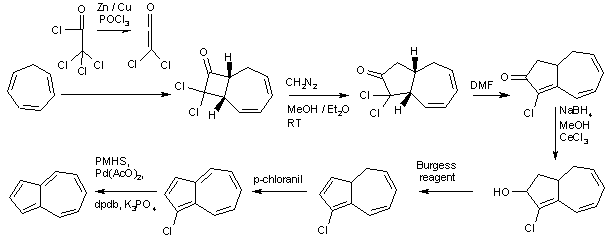Azulene
| |||
| Names | |||
|---|---|---|---|
| Preferred IUPAC name
Azulene | |||
| Systematic IUPAC name
Bicyclo[5.3.0]decapentaene | |||
| Identifiers | |||
| 275-51-4 | |||
| 3D model (Jmol) | Interactive image | ||
| ChEBI | CHEBI:31249 | ||
| ChemSpider | 8876 | ||
| ECHA InfoCard | 100.005.449 | ||
| KEGG | C13392 | ||
| PubChem | 9231 | ||
| UNII | 82R6M9MGLP | ||
| |||
| |||
| Properties | |||
| C10H8 | |||
| Molar mass | 128.17 g·mol−1 | ||
| Melting point | 99 to 100 °C (210 to 212 °F; 372 to 373 K) | ||
| Boiling point | 242 °C (468 °F; 515 K) | ||
| 0.02 g/l[1] | |||
| Thermochemistry | |||
| Std enthalpy of combustion (ΔcH |
−1266.5 kcal/mol[2] | ||
| Except where otherwise noted, data are given for materials in their standard state (at 25 °C [77 °F], 100 kPa). | |||
| | |||
| Infobox references | |||
Azulene is an organic compound and an isomer of naphthalene. Whereas naphthalene is colourless, azulene is dark blue. Its name is derived from the Spanish word azul, meaning "blue". Two terpenoids, vetivazulene (4,8-dimethyl-2-isopropylazulene) and guaiazulene (1,4-dimethyl-7-isopropylazulene), that feature the azulene skeleton are found in nature as constituents of pigments in mushrooms, guaiac wood oil, and some marine invertebrates.
Azulene has a long history, dating back to the 15th century as the azure-blue chromophore obtained by steam distillation of German chamomile. The chromophore was discovered in yarrow and wormwood and named in 1863 by Septimus Piesse. Its structure was first reported by Lavoslav Ružička, followed by its organic synthesis in 1937 by Placidus Plattner.
Structure and bonding

Azulene is usually viewed as resulting from fusion of cyclopentadiene and cycloheptatriene rings. Like naphthalene and cyclodecapentaene, it is a 10 pi electron system. It exhibits aromatic properties: (i) the peripheral bonds have similar lengths and (ii) it undergoes Friedel-Crafts-like substitutions. The stability gain from aromaticity is estimated to be half that of naphthalene.
Its dipole moment is 1.08 D,[4] in contrast with naphthalene, which has a dipole moment of zero. This polarity can be explained by regarding azulene as the fusion of a 6 π-electron cyclopentadienyl anion and a 6 π-electron tropylium cation: one electron from the seven-membered ring is transferred to the five-membered ring to give each ring aromatic stability by Hückel's rule. Reactivity studies confirm that seven-membered ring is electrophilic and the five-membered ring is nucleophilic.
The dipolar nature of the ground state is reflected in its deep colour, which is unusual for small unsaturated aromatic compounds. Another notable feature of azulene is that it violates Kasha's rule by exhibiting fluorescence from an upper-excited state (S2 → S0).[5]
Organic synthesis
Synthetic routes to azulene have long been of interest because of its unusual structure. In 1939 the first method was reported by St. Pfau and Plattner [6] starting from indane and ethyl diazoacetate.
An efficient one-pot route entails annulation of cyclopentadiene with unsaturated C5-synthons.[7] The alternative approach from cycloheptatriene has long been known, one illustrative method being shown below.[8]

Organometallic complexes
In organometallic chemistry, azulene serves as a ligand for low-valent metal centers, which otherwise are known to form π-complexes with both cyclopentadienyl and cycloheptatrienyl ligands. Illustrative complexes are (azulene)Mo2(CO)6 and (azulene)Fe2(CO)5.[9]
Related compounds
1-Hydroxyazulene is an unstable green oil and it does not show keto–enol tautomerism.[10] 2-Hydroxyazulene is obtained by hydrolysis of 2-methoxyazulene with hydrobromic acid. It is stable and does show keto–enol tautomerism.[11] The pKa of 2-hydroxyazulene in water is 8.71. It is more acidic than phenol or naphthol. The pKa of 6-hydroxyazulenes in water is 7.38 making it also more acidic than phenol or naphthol.[11]
In naphth[a]azulene, a naphthalene ring is condensed at the 1,2-positions of azulene. In one such system[12] deformation from planarity is found similar to that of tetrahelicene.
References
- ↑ http://deepblue.lib.umich.edu/bitstream/2027.42/42354/1/128-58-2-268_58n2p268.pdf
- ↑ Carl Salter; James B. Foresman (1998). "Naphthalene and Azulene I: Semimicro Bomb Calorimetry and Quantum Mechanical Calculations". Journal of Chemical Education. 75 (10): 1341. Bibcode:1998JChEd..75.1341S. doi:10.1021/ed075p1341.
- ↑ Harmon AD, Weisgraber KH, Weiss U (1980). "Preformed azulene pigments of Lactarius indigo (Schw.) Fries (Russulaceae, Basidiomycetes)". Cellular and Molecular Life Sciences (Experientia). 36 (1): 54–56. doi:10.1007/BF02003967. ISSN 1420-682X.
- ↑ Anderson A. G., Jr.; Stecker, B. M. (1959). "Azulene. VIII. A Study of the Visible Absorption Spectra and Dipole Moments of Some 1- and 1,3-Substituted Azulenes". J. Am. Chem. Soc. 81 (18): 4941–4946. doi:10.1021/ja01527a046.
- ↑ Tétreault, N.; Muthyala, R.S.; Liu, R.S.H.; Steer, R.P. (1999). "Control of the Photophysical Properties of Polyatomic Molecules by Substitution and Solvation: The Second Excited Singlet State of Azulene". J. Phys. Chem. A. 103 (15): 2524–31. doi:10.1021/jp984407q.
- ↑ Zur Kenntnis der flüchtigen Pflanzenstoffe VIII. Synthese des Vetivazulens Alexander St. Pfau , Pl. A. Plattner Helvetica Chimica Acta Volume 22 Issue 1, Pages 202–08 1939 doi:10.1002/hlca.19390220126
- ↑ Klaus Hafner; Klaus-Peter Meinhardt (1990). "Azulene". Org. Synth.; Coll. Vol., 7, p. 15
- ↑ Approach to the Blues: A Highly Flexible Route to the Azulenes Sébastien Carret, Aurélien Blanc, Yoann Coquerel, Mikaël Berthod, Andrew E. Greene, Jean-Pierre Deprés Angewandte Chemie International Edition Volume 44, Issue 32 , Pages 5130–33 2005 Abstract
- ↑ Melvyn R. Churchill "Transition Metal Complexes of Azulene and Related Ligands" Progress in Inorganic Chemistry 1970, volume 11. doi:10.1002/9780470166123.ch2
- ↑ Asao, Toyonobu; Shunji Ito; Noboru Morita (1989), "1-Hydroxyazulene and 3-hydroxyguaiazulene: Synthesis and their properties", Tetrahedron Letters, 30 (48): 6693–6696, doi:10.1016/S0040-4039(00)70653-8
- 1 2 Takase, Kahei; Toyonobu Asao; Yoshikazu Takagi; Tetsuo Nozoe (1968), "Syntheses and some properties of 2- and 6-hydroxyazulenes", Chemical Communications (London) (7): 368b–370, doi:10.1039/C1968000368B
- ↑ Yamamura, Kimiaki; Kawabata, Shizuka; Kimura, Takatomo; Eda, Kazuo; Hashimoto, Masao (2005). "Novel Synthesis of Benzalacetone Analogues of Naphth[a]azulenes by Intramolecular Tropylium Ion-Mediated Furan Ring-Opening Reaction and X-ray Investigation of a Naphth[1,2-a]azulene Derivative". The Journal of Organic Chemistry. 70 (22): 8902. doi:10.1021/jo051409f. PMID 16238325.

